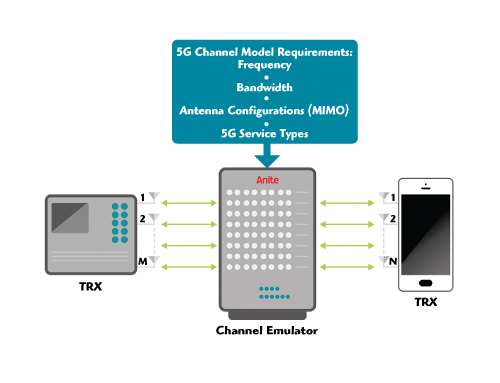
Device testing and measurement firm Anite has been at the centre of establishing the first radio channel models1 for 5G with the European working group METIS.2 Here, the company’s senior manager of channel emulation research and technology, Tommi Jämsä, discusses some of the technical challenges which must be overcome before 5G communications can become a reality.
5G, the next generation mobile and wireless communications system, represents a fundamental transformation in the development of device and network infrastructure technology. The ultra-broadband architecture will address the huge surge in mobile data consumption and the advanced capabilities of mobile wireless devices by combining new, complementary technologies with existing ones.
It will be designed to address a much broader range of applications, services and types of wireless mobile connectivity compared to previous generations, enabling new types, including HD and ultra-HD video streaming and virtual and augmented reality. 5G technology will also support the development of the Internet of Things (IoT) including machine-to-machine (M2M) connections for applications such as smart grid, car-to-car, emergency communication, eBanking and eHealth.
To ensure that these applications are enabled to their full potential, there needs to be an industry-wide focus on how to deliver these high-bandwidth critical applications. The end user’s experience will depend on a number of factors, including data rate, latency, reliability and ubiquitous coverage.
MOVING FROM MAXIMIZING CAPACITY TO INCREASING DENSITY
The mobile industry has used 4G technologies to maximize capacity, targeting peak data rates of 1 Gbps for low mobility and 100 Mbps for high mobility, as specified by the ITU’s Radio Communication Sector (ITU-R).3 5G will steer the focus more towards capacity density, offering a high number of simultaneous mobile users data rates of several Gbps – significantly higher than those currently available in 4G. A combination of higher data rates and number of devices contributes to a much greater requirement for the overall wireless capacity per square kilometre – as much as 1000 times higher than the capacity of LTE. Some delay-critical industrial M2M applications and tactile communications will demand very low latency. Low-powered devices will need to provide very long battery life – up to many years.
5G is expected to make use of massive multiple-input-multiple-output (MIMO),4 as it offers very high spectral efficiency and system capacity. Massive MIMO will utilize tens – or even hundreds – of antenna elements within the base station and dozens in the mobile device. The high number of devices in use, due to the forecasted rise in M2M applications, is expected to cause increased network interference. However, this is compensated to some degree by the fact that propagation losses at higher frequencies naturally reduce interference levels.
Higher frequencies bring other advantages as available spectrum below 6 GHz is very limited and a 1000-fold increase in capacity is very difficult – or even impossible – to achieve at current frequency bands. As a result, 5G is likely to operate on much higher frequencies (possibly millimeter waves) and adopt new air interface technologies such as filter bank multicarrier (FBMC) and non-orthogonal multiple access (NOMA). The frequency bands discussed among key industry players include cellular bands below 6 GHz as well as higher frequency bands such as 10, 28, 32, 43, 46 to 50, 56 to 76 and 81 to 86 GHz. However, these bands are currently just speculative. RF bandwidths are assumed to be around 100 MHz below 6 GHz but may be up to a few GHz at millimeter bands (i.e., frequencies from 30 to 300 GHz).
PAVING THE WAY TO 5G DEPLOYMENTS IN THE 2020s
To accelerate 5G technology development and testing, key industry players have formed a number of organizations and research bodies including Wireless World Research Forum (WWRF), METIS, EU Horizon 2020, Virtuoso and 5G Public-Private Partnership (5G PPP). The industry is currently in the research phase, which will be followed by system design, standardization and finally commercialization in the early 2020s.
ITU-R plans to finalize its vision of the 5G mobile broadband connected society later this year. ITU-R’s World Radio Communication Conference 2015 is expected to discuss additional spectrum in support of the future growth of international mobile telecommunication (IMT) systems. The ITU will further evaluate 5G technologies and will hopefully publish IMT-2020 specifications around year 2020.
The 3rd Generation Partnership Project (3GPP) is presently working on Release 13, which includes technology features for small cells, Wi-Fi offload, indoor positioning, device-to-device (D2D), massive MIMO (elevation beamforming), carrier aggregation with a higher number of carriers, machine-type communications and license assisted Access (LAA). The following release (Release 14) is expected to come out in 2016 and coincide with the system design phase of 5G development. Some 5G study items might be started in Release 14.
Subsequent 3GPP releases – 15 and 16 – are expected to concur with the standardization and commercialization phases, respectively. Technology features in 3GPP Releases 14, 15 and 16 will pave the way to 5G deployments in the early 2020s.
THE IMPORTANCE OF CHANNEL MODEL DEVELOPMENT
Many industry players have emphasized the importance of defining a channel model in early 5G research and development, since existing channel models are not deemed adequate. New channel models need to be developed to reflect radio wave propagation at very high frequencies, which are mostly new to the cellular development community.
5G will need to adapt to various radio channel conditions in a more efficient way, utilizing all dimensions of the radio channel: delay, frequency, time, location, polarization, azimuth and elevation angles. To do so, 5G channel models need to support a number of requirements, including:
- Wide frequency range (1 to 100 GHz)
- Wide bandwidth (hundreds of megahertz)
- Wide range of channel models for many 5G service applications
- An accurate 3D channel model with spherical waves for massive MIMO
- A mobility model for direct D2D and car-to-car communications
- Multi-link models for mobile ad hoc networks
- Models for special scenarios such as emergency calls and ultra-dense networks
Channel model evaluation for 5G technologies is essential as new standards are developed and new products are researched, developed and finally approved. New channel models need to be developed in the research phase to assess link, system and network performance in realistic propagation conditions as well as to compare different algorithms and technologies. The various channel model proposals are then assessed in terms of their performance in the standardization phase.
Research and development teams within chipset, device and network infrastructure manufacturers need the channel models to design device mechanics, antenna, radio and signal processing elements according to 5G market requirements. The same channel models are also used by test and measurement manufacturers, typically in channel emulators, to create a way of validating the 5G performance in a realistic, repeatable and reproducible manner (see Figure 1).

Figure 1 5G channel model for use in product development and research.
The METIS project task group led by Anite has published the world’s first channel models for 5G, an essential step towards further development of candidate 5G technologies. Co-funded by the European Commission, METIS is a consortium of 29 key wireless industry players and the first international and large-scale research activity on 5G.
Several channel measurement campaigns at various frequencies (2, 5, 26, 37, and 60 GHz) have been conducted within the METIS project. METIS’ final deliverable, due to be published in early 2015, will introduce updated 5G channel models. Because the proposed 5G requirements are quite challenging from a channel model development point of view, the suggested METIS channel models combine deterministic and stochastic (non-deterministic) models. On the deterministic side, a simplified environment based model – a “map-based model” – is consistent in space but isn’t ideal due to its location specific nature. The stochastic model is based on a widely accepted geometry-based stochastic channel model (GSCM), which has been standardized by 3GPP and ITU-R. The GSCM model developed for 5G supports three-dimensionality of the channel (3D), direct D2D links, higher frequencies, massive-MIMO as well as frequency dependent path loss models. However, GSCM alone is viewed as insufficient for 5G due to its lack of spatial consistency.
5G DEVELOPMENT UNDERLINES CHANNEL MEASUREMENT MODELING AND TESTING
There are many revolutionary aspects to 5G development as discussed above. 5G will utilize advanced technologies that set new requirements for testing, such as massive MIMO, D2D, millimeter wave, cognitive radio and cloud radio access network (C-RAN). The extremely challenging technical and performance requirements of 5G highlight the significance of radio channel testing compared to previous cellular technologies.
Conventional conductive testing of 5G devices is expected to be more difficult compared to 4G, because 5G is predicted to make use of a greater number of antenna elements (massive MIMO) in devices and infrastructure, adaptive antennas and operate on much higher frequencies. over-the-air (OTA) testing is therefore expected to play an even larger role in device or infrastructure performance verification.
Channel measurement and modeling is an essential part of 5G development due to more comprehensive performance requirements and use of new frequency bands (many of which are yet to be thoroughly investigated). This complexity is likely to put a greater emphasis on testing, as new devices and infrastructure are developed for 5G technology.
End Notes
- A channel model allows the propagation of a wireless signal between the transmitter and receiver to be predicted, including such factors as attenuation, multipath, interference and noise.
- METIS (Mobile and Wireless Communications Enablers for Twenty-Twenty Information Society) is a project under the Seventh Framework Programme for research and development (FP7).
- Requirements related to technical performance for IMT-Advanced radio interface(s), Report ITU-R M.2134 (2008), available online http://www.itu.int/.
- MIMO refers to system architectures where both the base station and the user’s device are equipped with multiple transmit and receive antennas.
